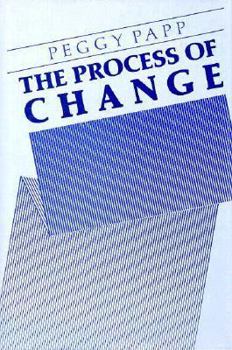The Process of Change
Select Format
Select Condition 
Book Overview
A guide for students and practitioners interested in exploring paradoxical and strategic interventions from a systems perspective, this book provides first-hand documentation of Papp s rich repertoire... This description may be from another edition of this product.
Format:Hardcover
Language:English
ISBN:089862052X
ISBN13:9780898620528
Release Date:November 1983
Publisher:Guilford Publications
Length:248 Pages
Weight:1.20 lbs.
Dimensions:1.0" x 6.2" x 9.2"
Related Subjects
Behavioral Sciences Clinical Clinical Psychology Compulsive Behavior Health, Fitness & Dieting Health, Fitness & Dieting Mental Health Politics & Social Sciences Psychiatry Psychology Psychology & Counseling Psychopathology Psychotherapy Psychotherapy, TA & NLP Science & Math Social Sciences Social WorkCustomer Reviews
2 ratings
Definitive work still influencing training and practice
Published by Thriftbooks.com User , 15 years ago
This is a definitive work in the field of faimly therapy that synthesizes several approaches and which still can be seen in use today. During my initial training in strategic family therapy, practicioners who had been trained by Jay Haley were also using many of Papp's approaches. Whether she got her ideas from them or vice versa remains to be seen. But she did a nice job of collecting and illustrating some very useful therapeutic approaches. You might also want to read "Making Hostile Words Harmless: A Guide to the Power of Positive Speaking For Helping Professionals and Their Clients" by Kate Cohen-Posey. She discusses Papp's use of therapeutic triangles and also expands upon the Strategic and Ericksonian approaches Papp was introduced to and which still have usefullness today.
Reaction to Papp's The Process of Change
Published by Thriftbooks.com User , 23 years ago
The process of change by Peggy Papp was a good introduction to the world of family therapy. The author addressed many issues related to the family systems, and was able to show the process of change, that took place in many families Peggy Papp was to counsel. Family system is a complex, dynamic structure that involves in itself a lot of significant factors that contribute to either healthy or unhealthy development. Generally, each family system is very unique, and has its own dance, way of communication, rules - spoken or unspoken. A family could be compared to a tangled ball of yarn, and a therapist should be aware of many components, before trying to untangle it. Such components are alliances, coalitions, unspoken rules, disengagement and etc. The goal of the therapist is to gather this information as much as possible for better results and use specific strategies to bring the change into the family. Of course any insignificant change brought to the family influences it greatly. "Change exacts a price and raises the question as to what repercussions will be for the rest of the system" (Papp, 1983). Peggy Papp suggests gathering information on different levels of the therapy. I agree that in order to understand family patterns, it is important to comprehend how all levels are connected and influence one another. The levels are the following: · Behavioral · Emotional · Ideational On the behavioral level the therapist should look for the events that direct to the happening of the problem in the family. Usually this is one of the most complex levels because in the beginning of the session it is hard to understand why family members act this or that way, and what caused them to do so. So the therapist gets a vague picture of the whole situation and many family secrets are still being hidden. On the emotional level the therapist's goal is to see how the family is communicating. The author calls it "the feeling level", how feelings are being expressed matters a lot during the therapy; this could give some cues to the therapist. Very often the problem lays in the following pattern: family members do not communicate with each other on a feeling level. Finally, the ideational level explores how the family perceives the problem, and what is the reaction to that perception. Papp states that the answer to understanding this level is revealed through the content and it would be helpful if the therapist gathers some information concerning the historical background of family members. What usually happens at this stage of exploration is that a certain theme revealed by the family member has a direct bearing on the presenting problem.I found the use of group during therapy interesting and at times peculiar. At first I'd a feeling of being disturbed by the group if I were a therapist. But Peggy Papp mentions some good sides of using a group in the therapy. One of them is to support either an identified patient or support a therapist and his decisions. Another o





